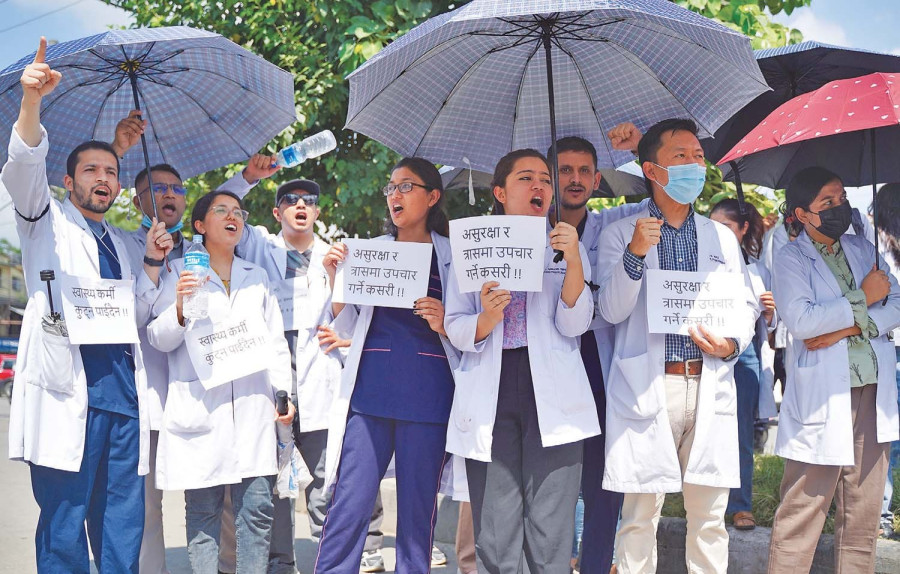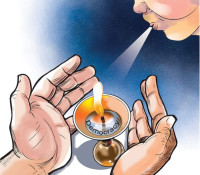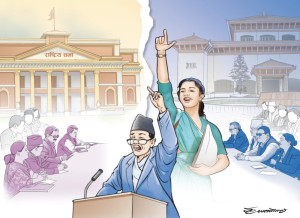Columns
Ending violence against doctors
Violent acts undermine the healthcare system and jeopardise the well-being of the individuals involved.
Divya Rana
Nepal has witnessed a disturbing surge in violence against medical professionals in recent months. Such acts have often been perpetrated under the misguided belief that all doctors are collectively responsible for any perceived medical negligence or malpractice. This not only poses immediate threats to doctors but also carries profound long-term psychological consequences, causing them to be reluctant to handle critical cases. This, in turn, severely compromises the delivery of healthcare services to patients. Therefore, there is an urgent need to create safe environments for medical practitioners where they can work with unwavering dedication.
Violence against medical professionals is a global issue that has persisted over the years. This phenomenon is not new to countries like China, Turkey, Iraq, India and Nepal. Early studies on violence against doctors can be traced back to the 1980s, revealing alarming statistics. In the United States, 57 percent of emergency care workers faced weapon threats, while 52 percent of doctors in the United Kingdom reported experiencing some form of violence. Notably, Asian countries, including China, India, Sri Lanka, Israel and Pakistan, have consistently reported higher rates of violence against medical professionals compared to countries in the Global North. The Indian Medical Association’s statistics suggest that as many as 75 percent of doctors in India have encountered various forms of violence at their workplaces, ranging from telephonic threats and verbal abuse to physical assaults causing simple or grievous injuries. There have been even more severe incidents like murder, vandalism and arson.
Identifying root causes
Elevated anxiety regarding diseases and their financial burden appear to be pivotal factors contributing to initiating violence. Reports say that factors such as lengthy hospital queues, inadequate communication, overcrowded facilities, protracted waiting times, inhospitable environment and subpar hygiene and sanitation serve as significant indicators enticing violence. An overarching dissatisfaction with the systemic issues of hospitals adds to the volatile environment.
In Nepal, a significant contributing factor to violence against doctors stems from a lack of faith in the legal and judicial system. Individuals with grievances often distrust the established mechanisms for seeking redress through legal means. Mob mentality has started to emerge, which escalates minor conflicts into full-blown violent crises within hospital settings. Another reason for mistrust is also due to perceived injustice within the medical domain, frequently catalysing disputes, which often remain unresolved, leaving patients resentful towards healthcare providers.
Recognising misconceptions
Medical personnel in some areas of Nepal are blindly trusted and even revered. Consequently, unfortunate medical outcomes are often attributed to medical malpractice or negligence, devoid of any substantial evidence or foundational basis. Conversely, a stark dearth of trust in the healthcare system prevails where people are inclined to denounce all doctors as driven solely by vested interests and greed, thereby engaging in unethical practices at the expense of the lives of patients. Although these allegations may serve as sensational media narratives designed for clickbait, they are not only frequently unsubstantiated but also profoundly reprehensible. This pervasive culture of animosity towards doctors, grounded in sentimentalities and inadequate evidence, underscores a deeply ingrained collective ignorance.
It’s essential to recognise that doctors, like any other professionals, encompass a wide spectrum of individuals, each with unique skills, experiences and ethical commitments. They cannot be uniformly held accountable for the actions of a few. While instances of medical negligence and malpractice may indeed be on the rise, it is both unjust and ignorant to indiscriminately implicate all doctors with malicious intentions. This grave misconception disregards the individuality of medical practitioners and fallaciously perpetuates a cycle of mistrust and animosity.
By failing to acknowledge the inherent diversity of doctors, society not only undermines the efforts of those who tirelessly serve their patients but also inadvertently contributes to a hostile environment where violence becomes an unjustifiable response to perceived shortcomings.
It is imperative to move beyond the casual use of the term laaparwahi (recklessness) and recognise the gravity of accusing a medical practitioner of negligence, malpractice or sheer recklessness. Regrettably, laaparwahi has become a buzzword among many Nepalis who may not fully comprehend the seriousness of such accusations. While it is undeniably critical for doctors to cultivate relationships with their patients and their families, attributing the rise in violence solely to a lack of attention to relationship building is grossly oversimplistic and unfair. The multifaceted issues contributing to violence against medical professionals require a more comprehensive examination, encompassing factors such as systemic deficiencies, communication challenges and public perceptions.
Holistic approach
A holistic strategy is imperative, encompassing broader healthcare system concerns, public education on the intricacies of medical practice and a robust emphasis on accountability through legal and regulatory frameworks to address the prevailing surge in violence against medical professionals.
Policymakers should focus on increased health budget allocations, leading towards improved healthcare facilities and a higher doctor-patient ratio. The government should ensure workplace safety, emphasise law enforcement, strengthen medical regulatory bodies and prioritise systemic, sustainable solutions, upholding the principle that violence is neither just nor constructive as a means of redress. These measures should discourage patients and their families from alleging negligence in cases of sudden patient deaths unless substantiated evidence is present. Media organisations should appreciate the nuanced nature of medical practice, recognising that diagnosis involves a hypothetico-deductive process that evolves with the emergence of new evidence and knowledge. These efforts are critical to ensure the safety and well-being of medical practitioners and patients. Society must dispel the inaccurate perception of doctors as an infallible, monolithic group and instead cultivate a nuanced understanding of the medical profession, recognising its inherent diversity and competence. It is crucial to acknowledge that violence against medical professionals undermines the broader healthcare system, ultimately jeopardising the well-being of the individuals involved.




 5.14°C Kathmandu
5.14°C Kathmandu















